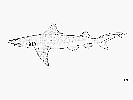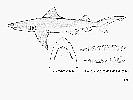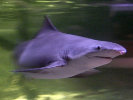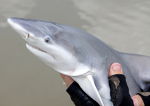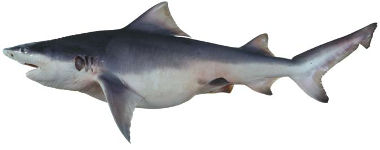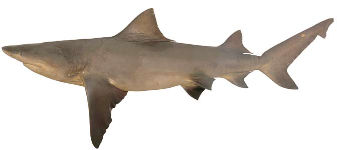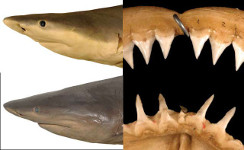Glyphis glyphis
(Müller & Henle, 1839)
Speartooth shark
Classification: Elasmobranchii Carcharhiniformes Carcharhinidae
Reference of the original description
Systematische Beschreibung der Plagiostomen. Berlin, Veit, pp. 1–200
Systematische Beschreibung der Plagiostomen. Berlin, Veit, pp. 1–200
Image of the original description
.jpg)
Glyphis glyphis (Müller & Henle, 1838)
.jpg)
Glyphis glyphis (Müller & Henle, 1838)
Synonyms / new combinations and misspellings
Carcharhinus glyphis, Carcharias glyphis, Carcharias (Prionodon) glyphis, Carcharinus glyphis, Glyphis cf. glyphis, Squalus (Carcharinus) glyphis
Carcharhinus glyphis, Carcharias glyphis, Carcharias (Prionodon) glyphis, Carcharinus glyphis, Glyphis cf. glyphis, Squalus (Carcharinus) glyphis
Description :
Citation: Glyphis glyphis (Müller & Henle, 1839): In: Database of modern sharks, rays and chimaeras, www.shark-references.com, World Wide Web electronic publication, Version 12/2025
Please send your images of "Glyphis glyphis" to info@shark-references.com
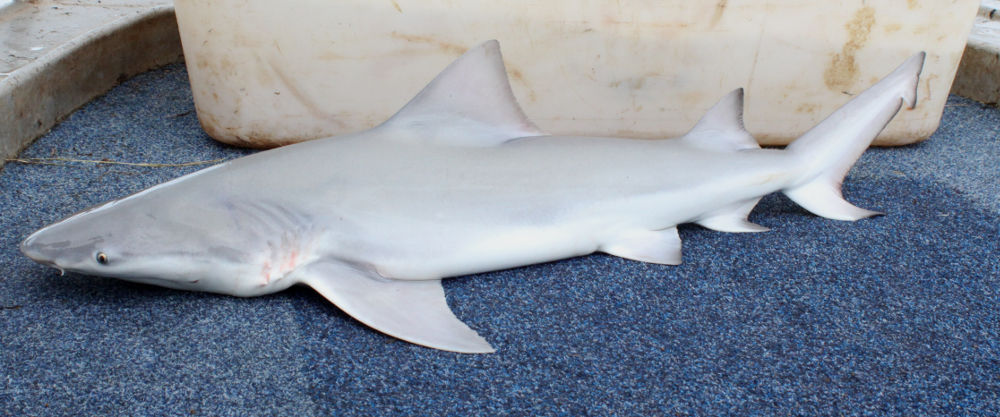
Glyphis glyphis (Müller & Henle, 1839), © Peter M. Kyne, Charles Darwin University, Australia

Glyphis glyphis (Müller & Henle, 1839), © Peter M. Kyne, Charles Darwin University, Australia
Common names
 Tiburón lanza,
Tiburón lanza,  Requin lancette,
Requin lancette,  Speartooth shark
Speartooth shark
 Tiburón lanza,
Tiburón lanza,  Requin lancette,
Requin lancette,  Speartooth shark
Speartooth shark
Short Description
Original diagnosis of COMPAGNO, WHITE & LAST, 2008 [3346]: A species of Glyphis with a short and broadly wedge-shaped snout as seen in lateral view. Closest distance from mouth to nostril 1.8–2.1 times nostril width. Lips usually concealing teeth when mouth is closed. Upper symphysis above or just in front of anterior eye margin. Interdorsal space 14.5–18.4% TL. Anterior margins of pectoral fins strongly convex, pectoral length 11.3–14.0% TL. Pelvic-fin anterior margin 7.0–9.0% TL and 36–45% of pectoral-fin anterior margin, pelvic-fin height 4.7–8.0% TL. First dorsal fin semifalcate, with concave posterior margin, free rear tip well anterior to about opposite pelvic-fin origins; length 16.2–19.6% TL. Second dorsalfin length 9.8–13.0% TL, anterior margin 7.0–10.7% TL, base 6.5–8.9% TL and 1.1–1.5 times second dorsal-fin height, height 5.8–6.9% TL and 70–84% of first dorsal height. Anal fin height 3.0–5.4% of total length and 53– 90% of second dorsal-fin height, base 81–91% of second dorsal-fin base. Caudal fin subterminal margin straight or weakly concave. Total vertebral counts 213–222; monospondylous precaudal counts 69–73 and 32–34% of total counts; diplospondylous precaudal counts 50–54 and 23–25% of total counts; diplospondylous caudal counts 89–99 and 42–45% of total counts; precaudal counts 123–124 and 55–58% of total counts. Watermark boundary just below eye and not visible below eyes on ventral view of head; watermark boundary sharply defined and regular along trunk in young, about twice nostril width above pelvic-fin bases. No discrete blackish blotch at base of dorsal pectoral-fin; pectoral-fin tip with a black blotch ventrally. Anal fin with a dusky to blackish distal web. Terminal caudal lobe with narrow black tip, ventral caudal lobe with black apical blotch.
Original diagnosis of COMPAGNO, WHITE & LAST, 2008 [3346]: A species of Glyphis with a short and broadly wedge-shaped snout as seen in lateral view. Closest distance from mouth to nostril 1.8–2.1 times nostril width. Lips usually concealing teeth when mouth is closed. Upper symphysis above or just in front of anterior eye margin. Interdorsal space 14.5–18.4% TL. Anterior margins of pectoral fins strongly convex, pectoral length 11.3–14.0% TL. Pelvic-fin anterior margin 7.0–9.0% TL and 36–45% of pectoral-fin anterior margin, pelvic-fin height 4.7–8.0% TL. First dorsal fin semifalcate, with concave posterior margin, free rear tip well anterior to about opposite pelvic-fin origins; length 16.2–19.6% TL. Second dorsalfin length 9.8–13.0% TL, anterior margin 7.0–10.7% TL, base 6.5–8.9% TL and 1.1–1.5 times second dorsal-fin height, height 5.8–6.9% TL and 70–84% of first dorsal height. Anal fin height 3.0–5.4% of total length and 53– 90% of second dorsal-fin height, base 81–91% of second dorsal-fin base. Caudal fin subterminal margin straight or weakly concave. Total vertebral counts 213–222; monospondylous precaudal counts 69–73 and 32–34% of total counts; diplospondylous precaudal counts 50–54 and 23–25% of total counts; diplospondylous caudal counts 89–99 and 42–45% of total counts; precaudal counts 123–124 and 55–58% of total counts. Watermark boundary just below eye and not visible below eyes on ventral view of head; watermark boundary sharply defined and regular along trunk in young, about twice nostril width above pelvic-fin bases. No discrete blackish blotch at base of dorsal pectoral-fin; pectoral-fin tip with a black blotch ventrally. Anal fin with a dusky to blackish distal web. Terminal caudal lobe with narrow black tip, ventral caudal lobe with black apical blotch.
Human uses
fisheries: of no interest
fisheries: of no interest
Habitat
demersal; freshwater; brackish; marine
demersal; freshwater; brackish; marine
Dentition
Lower anterior teeth with entire, weakly serrated edges in young, smooth basally in adults and subadults, tips not hastate in young but prominently so in adults; lower anterior teeth with low mesial and distal cusplets in young, absent in adults and subadults. Anteroposterior tooth row counts 13–14/13–14; total tooth row counts 26–29/27–29, or 53–58. [3346]
Lower anterior teeth with entire, weakly serrated edges in young, smooth basally in adults and subadults, tips not hastate in young but prominently so in adults; lower anterior teeth with low mesial and distal cusplets in young, absent in adults and subadults. Anteroposterior tooth row counts 13–14/13–14; total tooth row counts 26–29/27–29, or 53–58. [3346]
Remarks
shark-references Species-ID=2536;
shark-references Species-ID=2536;








